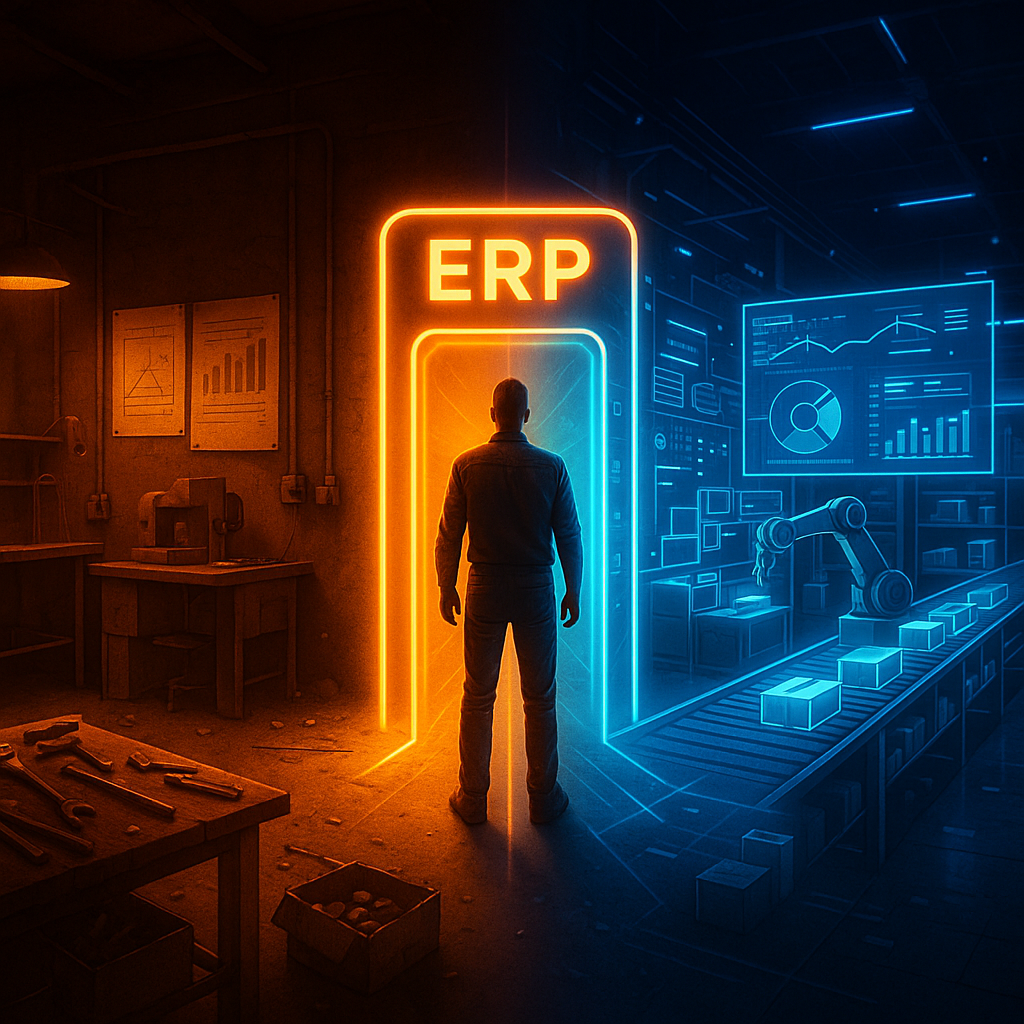Selecting ERP for Small Manufacturers: How to Choose the Right Fit for Your Business
For small and mid-sized manufacturers, every decision around systems and software has a real operational impact. Are your current tools giving you...
8 min read
 Blake Snider
:
Oct 1, 2025 12:45:07 PM
Blake Snider
:
Oct 1, 2025 12:45:07 PM
As of October 2025, energy and utility manufacturers face long lead times, strict compliance, and pressure to support renewable energy projects at scale. If you build transformers, switchgear, BESS, turbines, or substation hardware, you need an enterprise resource planning (ERP) for energy manufacturers that unifies engineering, production, quality, and aftermarket service.
This guide focuses on energy manufacturing and installed-base service, so you can choose the right ERP system that actually supports how you design, build, and maintain complex assets. If your teams run ETO/MTO products and maintain long‑life installed bases, use this to choose the right ERP system and integration patterns that lift OEE, OTIF, and first‑time fix.
The energy sector rewards precision and durability. A fit-for-purpose ERP solution should improve planning accuracy, product traceability, and the economics of field service. Below are the high-impact areas in the energy sector where a modern ERP helps energy manufacturers streamline operations and create lasting value.
Engineer-to-Order (ETO) and Configure-to-Order (CTO) dominate grid and generation projects. A robust ERP system must manage multi-level Bills of Materials (BOMs), effectivity dates, and revision control, while enabling ERP integration with Product Lifecycle Management (PLM) and CAD systems. Strong Engineering Change Request (ECR) and Engineering Change Order (ECO) workflows reduce costly rework and keep as-built records aligned with the final design. The right ERP provides configurable routing rules, attaches versioned documents at the operation level, and automates Non-conformance (NC) or CAPA creation when a change impacts work-in-process.
Utility projects often hinge on components with 16 to 40-week lead times. An APS module uses finite capacity and supplier availability to create a realistic master schedule. On the shop floor, the ERP platform generates dispatch lists that minimize changeovers and respect complex logic, such as heat batching. A powerful energy ERP system simulates material and capacity in tandem, so a planner can pull in a purchase order date and instantly see the knock-on effect on final testing and delivery dates.
Regulated grid components demand complete traceability. Your ERP software must capture supplier certifications, inspection results, and test values, tying them directly to specific serials and work orders. When a defect appears, your team should be able to query a single serial number and instantly identify affected sibling units and supplier batches. The importance of ERP is clear when aligning your QMS with ISO 9001 and maintaining provenance through certificates, as the ERP system provides the integrated data systems necessary for compliance.
A single missed delivery can jeopardize a customer’s critical outage window. A comprehensive ERP solution should utilize supplier scorecards that automatically weight key metrics. The ERP system drives dual-source strategies for high-risk parts, tightens inspection requirements based on performance trends, and maintains approved manufacturer lists (AMLs). For safety-critical items, the ERP helps store compliance evidence and links it directly to purchase receipts and serial numbers for a complete audit trail.
Your products live in harsh, remote conditions for decades. An ERP for the energy industry enables detailed installed-base records that track each unit’s specific configuration and complete service history. By integrating condition data via IIoT/SCADA, ERP systems allow you to generate work orders before a failure occurs. Start with simple thresholds and evolve to advanced models that look for deltas in energy use that often precede faults, referencing NERC CIP reliability standards to ensure secure data systems.
Aftermarket margin is critical in the energy and utility sectors. Your ERP system should automatically calculate warranty reserves, manage Return Material Authorization (RMA) workflows, and support various service contracts. A mobile web-based ERP app provides technicians with offline parts lookup and commissioning checklists tied to a serial number. First-time fix rates improve dramatically when using the ERP system to reserve van stock based on the scheduled job.
Large equipment often requires multi-day jobs and specialized crews. A true utility ERP for manufacturing should handle multi-resource scheduling and track qualifications. The system must tie the service schedule to parts logistics so that pick lists and shipment cutoffs reflect the crew's plan. For high-criticality sites, the ERP for energy can pre-position spares with min/max levels that automatically adjust based on real-world failure data.
Energy manufacturers often ask whether an ERP system can replace an Enterprise Asset Management (EAM) or Computerized Maintenance Management System (CMMS) for fielded assets. The most effective strategy is to split the problem, as the benefits of ERP are commercial, while EAM/CMMS excels at reliability analytics.
If you sell and service your own equipment, the ERP system should orchestrate service quotes, contracts, parts pricing, and technician labor capture. It also handles warranty claims and ties all costs back to the originating serial number. This ERP integration ensures that service margins are visible, feeding directly into your pricing strategy for renewals and spares.
If you manage fleets of mixed OEM equipment or need deep reliability features like RCM or FMEA libraries, an EAM/CMMS typically leads. Use ERP for financials, but let the EAM structure sites and components, passing work and material needs into the ERP platform. The integration must reconcile asset IDs with ERP serials to avoid mismatched service histories.
Establish a clear system-of-record model: your ERP solution is for commercial and financial objects, while the EAM is for asset condition and maintenance schedules. Exchange BOM and serial master data daily, and stream work orders one way and confirmations the other. It is critical to secure all telemetry paths and follow DOE guidance on grid modernization and cybersecurity.
Energy and utility manufacturers rely on real-time data to streamline their complex processes. Key ERP integrations reduce manual entry, prevent version drift, and prioritize workflows that improve safety and efficiency.
Condition data helps schedule maintenance and allocate spares more intelligently. Start with a narrow list of data tags per model and define operational thresholds. Route alerts into the ERP system as service requests automatically attached to the correct serial number and service contract, referencing IEC 62443 industrial security standards to harden all connections.
Connect machines and work centers to your ERP software to automatically log cycle counts, scrap, and test results. This data can feed statistical process control (SPC) dashboards and trigger a CAPA process when trends drift. The ERP solution should reconcile as-built serials with test signatures so field failures can be traced back to specific production stations.
Tight PLM ERP integration prevents the use of stale drawings and incorrect revisions during manufacturing. Sync engineering parts to ERP items while preserving critical attribute metadata like voltage class and insulation type. When an engineering change is approved in PLM, the shop floor instantly sees the latest traveler and old revisions are automatically quarantined.
The process of choosing the right ERP should be driven by your specific use cases. Comprehensive suites like IFS cover ERP, EAM, and Service in a unified stack—a model that fits manufacturers with complex equipment and long service tails. Niche energy ERPs, offered by other ERP vendors, can be lighter to deploy but may struggle with ETO processes.
Choose IFS when you need strong project manufacturing, embedded service, and asset management in a single software solution. Typical scenarios include transformer rebuild programs and turbine overhauls. Having unified planning and service history in one ERP platform reduces hand-offs and data gaps, supporting growth into new regions.
If your product catalog is stable and compliance is modest, a smaller industry solution can work. You may get a faster time-to-value with a simpler ERP implementation. The trade-off is often weaker ETO functionality and integration complexity as needs expand, so be sure to validate their integration roadmaps early.
Rolling out a new ERP system in the energy industry succeeds when the scope is crisp and data is clean. Consider when implementing an ERP to start with the use cases that will have the biggest impact on delivery and uptime, then expand once the core is stable.
Cut your ERP implementation by product family or plant area. Take one complete value stream from order to cash—including aftermarket service—to prove out every hand-off. Keep the configuration consistent across phases and use templates to accelerate future rollouts, resisting one-off customizations that limit future options.
Define your item, BOM, and serial number rules before transactions flow through the ERP system. Decide what gets a serial, what stays at the lot level, and what critical attributes must follow each part through its lifecycle. Establish certificate capture processes at receiving and enforce electronic travelers so that provenance is never lost.
Lock down integrations, segment networks, and test field data paths under failure conditions. Build role-based training for planners, buyers, technicians, and quality engineers. Before go-live, simulate both a product recall and a critical field failure to ensure your queries and reports return accurate answers fast enough to manage real-world incidents.
Use both where they’re strongest: ERP handles quotes, contracts, inventory, costing, and service entitlements; EAM/CMMS owns asset hierarchies, PM plans, and condition data. A proven pattern is EAM releases the work order, ERP reserves parts and books costs, and confirmations close the job and update warranty. If service is >30% of revenue or you ship complex ETO products, let ERP lead; if you manage multi‑OEM fleets, let EAM lead and integrate at the serial/asset ID.
An energy ERP dispatches with skills/permit checks, travel time, and SLA rules so the right crew and parts arrive once. Installed‑base records pre‑pick van stock and model‑specific specs, lifting first‑time fix and shrinking truck rolls. Mobile offline capture syncs labor, parts, photos, and test values to warranty and reliability analytics for faster CAPA.
Design to frameworks, not audits: NERC CIP for secure operations, ISO 55001 for asset information lifecycle, and IEC 62443 for industrial zones/conduits. Configure audit trails, e‑signatures, and evidence retention to each control set, and tie supplier certificates to lots/serials. Build one‑click reports you can run in minutes during an audit instead of assembling spreadsheets.
Prioritize APS/MRP, shop‑floor data collection, quality/traceability, and service management—these move uptime and delivery fastest. Keep the footprint lean at first; add PLM and EAM integrations after master data and serial rules are proven on one value stream. Success shows up as better schedule adherence and sub‑hour traceability from field serial to supplier heat lot.
Capture BOM revision, firmware/software, calibration/test results with tolerances, torque/weld parameters, supplier lot/heat numbers, certificates, and as‑installed site/configuration. Link every service action—parts, labor, diagnostics, photos—to the serial to preserve a complete history. Retain for the asset life (often 10–30 years) and ensure searches return the full chain in seconds to speed investigations and predictive models.
Energy and utility manufacturers win with ERP when ETO governance, APS, serial traceability, and field service work together. Pair ERP with EAM/CMMS where it adds reliability depth, and harden integrations to SCADA, MES, PLM, and GIS. Measure OEE, OTIF, FTFR, and warranty cost so improvements show up fast.
List your top three use cases (e.g., ETO change control, predictive maintenance, field service parts). Map the master data you need (items, BOMs, serial rules, certificates) and run a mock trace from a field serial back to the supplier heat lot. Request vendor demos that prove the hardest scenario first—include a live traceability query and a mobile service job with van‑stock reservation. Baseline KPIs now so post‑go‑live gains are visible and defensible.
Astra Canyon guides manufacturers through ERP programs that unify manufacturing, quality, and field service. We implement IFS Cloud and adjacent platforms with a practical focus on ETO, serial traceability, and installed‑base service—then layer AI/ML and RPA where they pay off (predictive triggers, technician scheduling, spares forecasting). With more than two decades of plant and field experience, we align systems to high‑consequence work and sector frameworks (NERC CIP, IEC 62443, ISO 9001/55001). See our work with Nomad Global Communication Solutions for a secure, end‑to‑end transformation example.
For a broader view of suites, visit Top ERP systems for manufacturing. Ready to scope your path? Book a utility-sector ERP consultation and see IFS and alternatives in action.

For small and mid-sized manufacturers, every decision around systems and software has a real operational impact. Are your current tools giving you...

In electronics and component manufacturing, the gap between success and failure is measured in microns and milliseconds. Producers face a unique...

6 min read
The pet food industry is booming. Pet owners are spending record amounts and demanding human-grade quality and ingredient transparency for their...